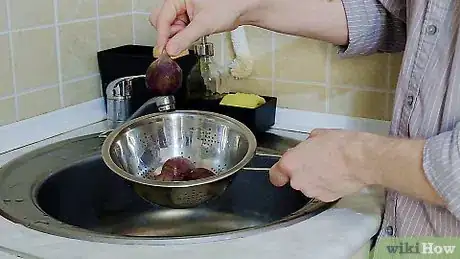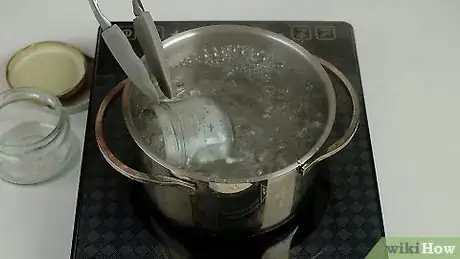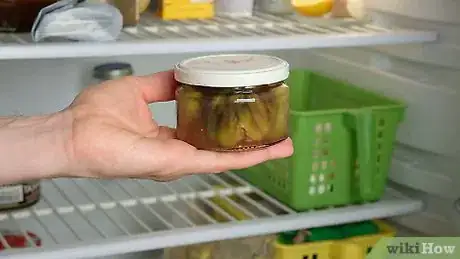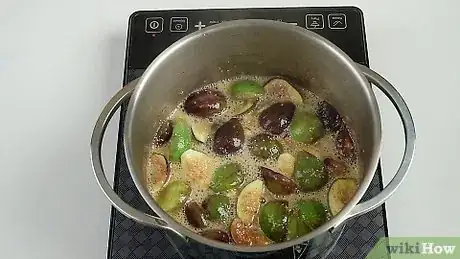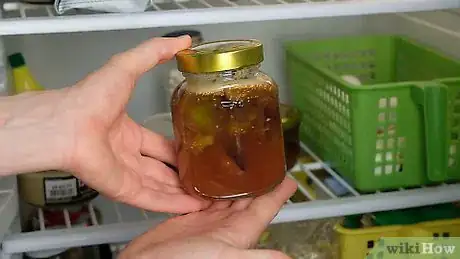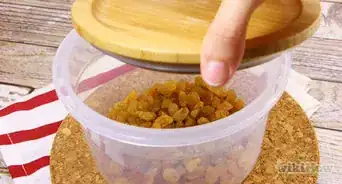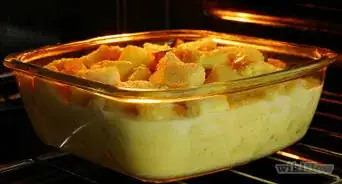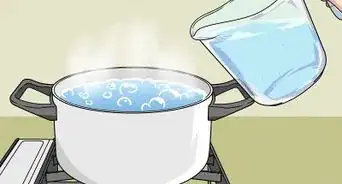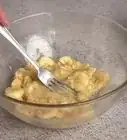This article was co-authored by wikiHow staff writer, Jessica Gibson. Jessica Gibson is a Writer and Editor who's been with wikiHow since 2014. After completing a year of art studies at the Emily Carr University in Vancouver, she graduated from Columbia College with a BA in History. Jessica also completed an MA in History from The University of Oregon in 2013.
The wikiHow Video Team also followed the article's instructions and verified that they work.
This article has been viewed 18,757 times.
Learn more...
Since figs have such a short season, it's a great idea to preserve some for later. If you'd like to avoid the usual sugar syrups, boil whole figs and pack them in jars with hot water. You'll need to add bottled lemon juice and process the jars so they're safe for keeping. If you'd still like something sweet without the sugar, cook the figs down into a jam along with lemon zest and honey. Since the jam isn't processed, refrigerate or freeze it until you're ready to use it.
Ingredients
- Whole figs
- Bottled lemon juice
Yield depends on how much fruit you have
- 2 pounds (910 g) fresh figs
- 1 1/2 cups (510 g) honey
- 1⁄4 cup (59 ml) water
- 1⁄4 cup (59 ml) of bottled lemon juice
- 2 teaspoons (4 g) lemon zest
Makes 3 to 4 cups (975 to 1300 g)
Steps
Preserving Whole Figs
-
1Choose and rinse fresh figs. Get out as many fresh figs as you'd like to preserve and rinse them under cool water to remove any dirt. Don't preserve any figs that are bruised or have soft spots. Instead, choose firm figs without any cracks.
- 16 pounds (7,300 g) of figs will fill about 9 pint jars.
-
2Put the figs in a pot with water and boil them for 3 to 4 minutes. Place the whole figs in a pot and pour enough water to cover them by 1 in (2.5 cm). Turn the burner to high and bring the water to a boil. Boil the figs until they soften a little.Advertisement
-
3Sterilize your canning jars. Put several clean pint (500 ml) or half-pint (250 ml) canning jars and bands into a separate pot with hot water. Bring the jars to a boil for 10 minutes to sterilize them and then turn off the burner.
- Leave the sterilized jars in the hot water until you're ready to fill the jars. They should be warm when you fill them so they don't break when filled with the hot figs.
-
4Fill the hot jars with the hot figs and add bottled lemon juice. Use tongs to lift the sterilized jars out of the hot water. Spoon the hot figs into each jar so they're full. If you used pint jars, measure 1 tablespoon (15 ml) of bottled lemon juice into each filled jar. If you used half-pint jars, add 1⁄2 tablespoon (7.4 ml) of bottled lemon juice to each filled jar.
- It's important to use bottled lemon juice so you know the acidity is high enough. Fresh lemon juice may not be acidic enough to safely preserve the figs.
-
5Pour hot water into each jar and leave 1 in (2.5 cm) of headspace. Carefully pour hot water from the pot that you boiled the figs in into each jar. Leave enough headspace so the jars process correctly and don't leak.
- If you leave too much headspace, the figs spoil too quickly.
- If you prefer, you can use hot apple juice or white grape juice instead of water.
-
6Use a butter knife to remove air bubbles and put the lids on. Run a knife inside each jar to pop any air bubbles that may be trapped. Wipe the rims of the jars with a clean cloth and set a new lid on each jar. Screw on a sterilized lid until it's fingertip tight.[1]
- Don't screw the lid on too tightly or the air in the jar won't be able to escape when you're processing it.
-
7Process the jars in a hot-water canner for 20 minutes. Use canning tongs to lower the filled jars into a large canning pot filled with hot water. The water should come 2 in (5 cm) over the jars. Turn the burner to high and bring the water to a boil. Put the lid on the pot and boil the jars for 20 minutes.[2]
- If you're at a high elevation (over 1,000 feet or 306 m), add 5 to 15 minutes to the processing time.
-
8Remove and store the figs at room temperature for up to 1 year. Use the canning tongs to lift the jars up and out of the canning pot. Let the jars cool at room temperature for 24 hours and then check the seals. Store the unopened jars of figs for up to 1 year.[3]
- Once you open a jar, store it in the refrigerator and use the figs within 2 to 3 days.
Fig Honey Jam
-
1Rinse and cut 2 pounds (910 g) of fresh figs. Place the clean figs on a cutting board and cut off the stems. Then cut each fig into 4 equal pieces. Put the fig quarters into a large saucepan or pot.[4]
-
2Soak the figs in honey and water for 20 minutes. Pour 1⁄4 cup (59 ml) of water and 1 1/2 cups (510 g) of honey in with the figs. Stir the mixture gently and let it sit uncovered for 20 minutes.[5]
- The figs will plump up a little and soften as they soak.
-
3Boil the figs for 2 minutes. Turn the burner to medium-high and let the figs in honey syrup come to a boil while you stir them every once in a while. Keep boiling the figs for 2 minutes and stir them occasionally to prevent them from sticking.
-
4Simmer the figs for 45 minutes to 1 hour. Turn the burner down to medium or medium-low so the figs bubble gently. Simmer the figs and stir them occasionally to prevent them from sticking.
- The figs will soften and break apart a little as they cook. For smoother jam, you can mash them with a potato masher.
-
5Stir in the lemon juice and zest. Pour in 1⁄4 cup (59 ml) of bottled lemon juice and stir in 2 teaspoons (4 g) of lemon zest. Keep cooking the fig jam for 3 to 5 minutes.
-
6Turn off the burner and fill the jars with jam. Let the jam cool for about 5 minutes before you ladle it into clean jam jars. You'll need 3 to 4 half-pint jars. Seal the jars with the lids and leave them to cool until they're at room temperature.
- If you prefer, you can put the jam into freezer-safe jars or plastic containers.
-
7Refrigerate the jam for 3 to 4 weeks. Put the jam jars in the refrigerator and use them within 3 to 4 weeks. If you want to freeze the jam instead, use it within 6 months.
- This jam can't be stored as long as most jams because there's no sugar to preserve it. This is why you have to refrigerate or freeze it.
Things You'll Need
Whole Preserved Figs
- Measuring spoons
- Jam jars and lids
- Large pot
- Canning tongs
- Saucepan or pot
Fig Honey Jam
- Measuring cups and spoons
- Knife and cutting board
- Large saucepan or pot
- Spoon
- Zester
- Ladle
- Jam jars and lids
References
- ↑ http://www.healthycanning.com/canning-asian-pears/#fn1-1266
- ↑ http://www.healthycanning.com/canning-asian-pears/#fn1-1266
- ↑ http://www.healthycanning.com/home-canning-fruit-sugar-free/
- ↑ http://tasty-yummies.com/fig-honey-jam-gluten-free-refined-sugar-free/
- ↑ http://tasty-yummies.com/fig-honey-jam-gluten-free-refined-sugar-free/
